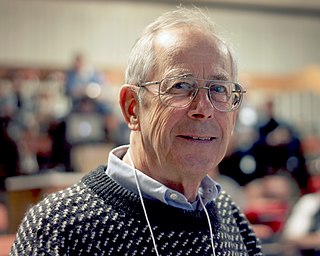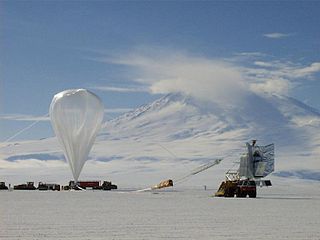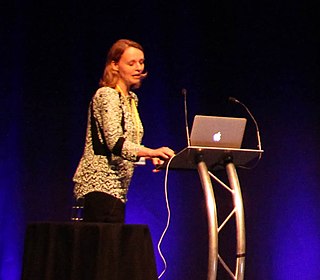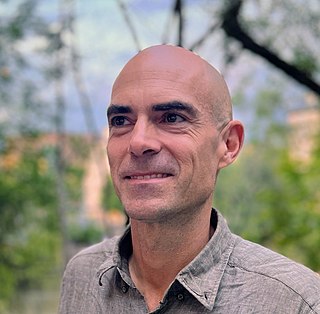Related Research Articles

Physical cosmology is a branch of cosmology concerned with the study of cosmological models. A cosmological model, or simply cosmology, provides a description of the largest-scale structures and dynamics of the universe and allows study of fundamental questions about its origin, structure, evolution, and ultimate fate. Cosmology as a science originated with the Copernican principle, which implies that celestial bodies obey identical physical laws to those on Earth, and Newtonian mechanics, which first allowed those physical laws to be understood.

The cosmic microwave background is microwave radiation that fills all space in the observable universe. It is a remnant that provides an important source of data on the primordial universe. With a standard optical telescope, the background space between stars and galaxies is almost completely dark. However, a sufficiently sensitive radio telescope detects a faint background glow that is almost uniform and is not associated with any star, galaxy, or other object. This glow is strongest in the microwave region of the radio spectrum. The accidental discovery of the CMB in 1965 by American radio astronomers Arno Penzias and Robert Wilson was the culmination of work initiated in the 1940s.

Astrophysics is a science that employs the methods and principles of physics and chemistry in the study of astronomical objects and phenomena. As one of the founders of the discipline, James Keeler, said, Astrophysics "seeks to ascertain the nature of the heavenly bodies, rather than their positions or motions in space–what they are, rather than where they are." Among the subjects studied are the Sun, other stars, galaxies, extrasolar planets, the interstellar medium and the cosmic microwave background. Emissions from these objects are examined across all parts of the electromagnetic spectrum, and the properties examined include luminosity, density, temperature, and chemical composition. Because astrophysics is a very broad subject, astrophysicists apply concepts and methods from many disciplines of physics, including classical mechanics, electromagnetism, statistical mechanics, thermodynamics, quantum mechanics, relativity, nuclear and particle physics, and atomic and molecular physics.

Rashid Alievich Sunyaev is a German, Soviet, and Russian astrophysicist of Tatar descent. He got his MS degree from the Moscow Institute of Physics and Technology (MIPT) in 1966. He became a professor at MIPT in 1974. Sunyaev was the head of the High Energy Astrophysics Department of the Russian Academy of Sciences, and has been chief scientist of the Academy's Space Research Institute since 1992. He has also been a director of the Max Planck Institute for Astrophysics in Garching, Germany since 1996, and Maureen and John Hendricks Distinguished Visiting Professor in the School of Natural Sciences at the Institute for Advanced Study in Princeton since 2010.
The discovery of cosmic microwave background radiation constitutes a major development in modern physical cosmology. In 1964, US physicist Arno Allan Penzias and radio-astronomer Robert Woodrow Wilson discovered the CMB, estimating its temperature as 3.5 K, as they experimented with the Holmdel Horn Antenna. The new measurements were accepted as important evidence for a hot early Universe and as evidence against the rival steady state theory as theoretical work around 1950 showed the need for a CMB for consistency with the simplest relativistic universe models. In 1978, Penzias and Wilson were awarded the Nobel Prize for Physics for their joint measurement. There had been a prior measurement of the cosmic background radiation (CMB) by Andrew McKellar in 1941 at an effective temperature of 2.3 K using CN stellar absorption lines observed by W. S. Adams. Although no reference to the CMB is made by McKellar, it was not until much later after the Penzias and Wilson measurements that the significance of this measurement was understood.
Observational cosmology is the study of the structure, the evolution and the origin of the universe through observation, using instruments such as telescopes and cosmic ray detectors.

Phillip James Edwin Peebles is a Canadian-American astrophysicist, astronomer, and theoretical cosmologist who is currently the Albert Einstein Professor in Science, emeritus, at Princeton University. He is widely regarded as one of the world's leading theoretical cosmologists in the period since 1970, with major theoretical contributions to primordial nucleosynthesis, dark matter, the cosmic microwave background, and structure formation.

In astronomy and observational cosmology, the BOOMERanG experiment was an experiment which measured the cosmic microwave background radiation of a part of the sky during three sub-orbital (high-altitude) balloon flights. It was the first experiment to make large, high-fidelity images of the CMB temperature anisotropies, and is best known for the discovery in 2000 that the geometry of the universe is close to flat, with similar results from the competing MAXIMA experiment.

Ralph Asher Alpher was an American cosmologist, who carried out pioneering work in the early 1950s on the Big Bang model, including Big Bang nucleosynthesis and predictions of the cosmic microwave background radiation.
Robert Herman was an American scientist, best known for his work with Ralph Alpher in 1948–50, on estimating the temperature of cosmic microwave background radiation from the Big Bang explosion.

Charles L. Bennett is an American observational astrophysicist. He is a Bloomberg Distinguished Professor, the Alumni Centennial Professor of Physics and Astronomy and a Gilman Scholar at Johns Hopkins University. He is the Principal Investigator of NASA's highly successful Wilkinson Microwave Anisotropy Probe (WMAP).

Lyman Alexander Page, Jr. is the James S. McDonnell Distinguished University Professor of Physics at Princeton University. He is an expert in observational cosmology and one of the original co-investigators for the Wilkinson Microwave Anisotropy Probe (WMAP) project that made precise observations of the electromagnetic radiation from the Big Bang, known as cosmic background radiation.
TopHat was a scientific experiment launched from McMurdo Station in January 2001 to measure the cosmic microwave background radiation produced 300,000 years after the Big Bang. The balloon was launched on January 2, 2001 and proceeded to fly for 644 hours over the continent of Antarctica before landing on January 31, 2001. The balloon flew over the continent 38 kilometers (125,000 ft) above the ground. The working payload was shut down on January 10, 2001 after the liquid cryogens cooling the detectors were exhausted, and the balloon simply circled the continent until it was safe to land. The vorticial winds that typically carry balloons around the continent dissipated part of the way through the flight, and the balloon had to be terminated in a suboptimal location. The landing missed the targeted ice shelf by around one half mile, and while the discs containing the information were recovered safely using a Twin Otter, the gondola itself had not been recovered by August 2001.

BICEP and the Keck Array are a series of cosmic microwave background (CMB) experiments. They aim to measure the polarization of the CMB; in particular, measuring the B-mode of the CMB. The experiments have had five generations of instrumentation, consisting of BICEP1, BICEP2, the Keck Array, BICEP3, and the BICEP Array. The Keck Array started observations in 2012 and BICEP3 has been fully operational since May 2016, with the BICEP Array beginning installation in 2017/18.
Calvin Barth Netterfield, known as Barth Netterfield, is a Canadian astrophysicist, and a Professor in the Department of Astronomy and the Department of Physics at the University of Toronto. He is a leading expert in the development of balloon-borne telescopes. These are astrophysical experiments that are lifted into the stratosphere by high-altitude balloons where they conduct observations that would be hindered by atmospheric interference if done on the ground. Netterfield is primarily known for his work in observational cosmology, specifically in developing instrumentation to observe the cosmic microwave background (CMB) radiation. Most notably, he was a key member of the instrument team for BOOMERANG, the experiment that made one of the first accurate determinations of the age, geometry, and mass-energy content of the universe. More recently, he has delved into the field of submillimetre astronomy and the physics of star formation, through his involvement with the BLAST telescope. Netterfield was featured prominently in BLAST!, a documentary film about the 2005 and 2006 flights of BLAST from Sweden and Antarctica.

Brian Gregory Keating is an American cosmologist. He works on observations of the cosmic microwave background, leading the BICEP, POLARBEAR2 and Simons Array experiments. He received his PhD in 2000, and is a distinguished professor of physics at University of California, San Diego, since 2019. He is the author of two books, Losing The Nobel Prize and Into the Impossible.
Clement Laurence Pryke is an English-American physicist, focusing in astrophysics and cosmology, particularly on the cosmic microwave background.

Joanna Dunkley is a British astrophysicist and Professor of Physics at Princeton University. She works on the origin of the Universe and the Cosmic microwave background (CMB) using the Atacama Cosmology Telescope, the Simons Observatory and the Large Synoptic Survey Telescope (LSST).
Abigail Goodhue Vieregg is a professor of physics at the Enrico Fermi Institute and Kavli Institute of Cosmology, University of Chicago, specializing in neutrino astrophysics and cosmology. Her work focuses on cosmic high-energy neutrinos and mapping the cosmic microwave background.

Oliver Zahn is US/German theoretical astrophysicist, data scientist, and entrepreneur, best known for developing algorithms for astrophysical data analysis and widely cited discoveries of phenomena in the history of the Universe. He is also known for his more recent work as founder and CEO of Climax Foods, a California-based biotechnology company modeling dairy and other animal products directly from plant ingredients. Prior to becoming an entrepreneur, Zahn directed UC Berkeley's Center for Cosmological Physics alongside George Smoot and Saul Perlmutter and was Head of Data Science at Google
References
- 1 2 "John Ruhl, Connecticut Professor". Physics faculty. Case Western Reserve University. Retrieved 2023-08-16.
- ↑ Holstein, Barry R. (May 1992). "Review of Princeton Problems in Physics with Solutions". American Journal of Physics. 60 (5): 477–478. Bibcode:1992AmJPh..60..477N. doi:10.1119/1.16855.
- ↑ "John Edward Ruhl". Astrogen. American Astronomical Society. Retrieved 2023-08-16. See also Ruhl's dissertation at ProQuest 304101104.
- ↑ Rejcek, Peter (April 27, 2015). "A sticky problem: SPIDER seeks clues to the enigma of how the universe first expanded". The Antarctic Sun. United States Antarctic Program. Retrieved 2023-08-16.
- ↑ Hutchison, Kristan (December 1, 2002). "Looking for the dark side of the universe" (PDF). The Antarctic Sun. United States Antarctic Program. Retrieved 2023-08-16.
- ↑ "Scientists Use South Pole Telescope to Produce the Most Detailed Images of the Early Universe". National Science Foundation. December 13, 2002. Retrieved 2023-08-16.
- ↑ Beasley, Dolores (April 29, 2001). "New Boomerang Findings Reveal "Music" of the Early Universe". NASA. Retrieved 2023-08-16.
- ↑ "Fellows nominated in 2005 by the Division of Astrophysics". APS Fellows archive. American Physical Society. Retrieved 2023-08-16.
- ↑ "John Ruhl's commitment to student success earns him Diekhoff Award for Mentoring". The Daily. Case Western Reserve University. May 5, 2016. Retrieved 2023-08-16.